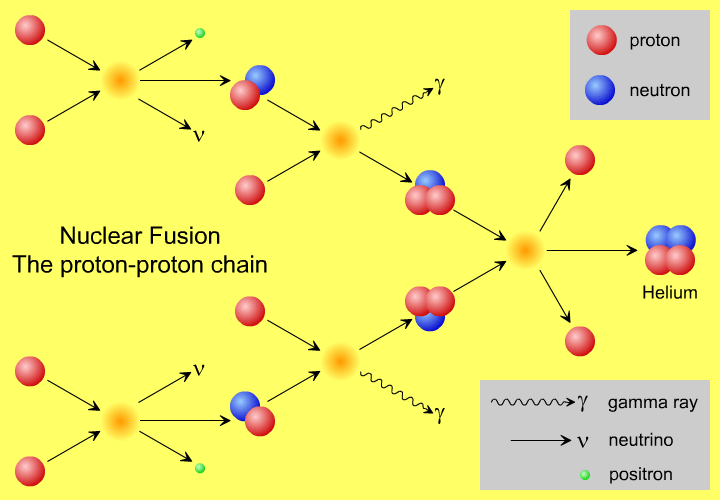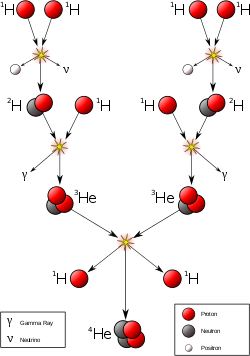Fusion for Dummies
Fusion for Dummies
The source of all heat and light in the universe comes from stars, and the main way that stars produce heat and light is by nuclear fusion, mostly hydrogen into helium.
How does this actually work?
First of all, one has to realize that a hydrogen atom is made up of a proton and an electron, which in the core of a star is stripped away. In other words, protons and electrons are free to do as they please because they've been divorced. In the proton-proton chain reaction, which is the main process inside the core of stars, four protons fuse to form a helium-4 nucleus. This is a two-stage process.

The first stage is when two protons fuse to form a di-proton. The di-proton subsequently decays into a deuterium nucleus. The overall reaction releases a positron and a neutrino when one proton changes into a neutron, which is needed to make a helium nucleus. This process is fast because it's ruled by the strong nuclear force.

Think about it this way. Protons are positively charged and positive charges repel. They want nothing to do with one another. But, because of the tremendous pressure and temperature in the core of a star-think millions of degrees-they are forced together in a fatal lover's encounter. This love act is very violent and produces an ugly offspring that bigger than both parents.
These angry lovers don't get much sex together. A single proton avoids fusion on average for a billion years. That's a long time to wait to get laid, or in this case, fused.
The di-proton step is slow because it's ruled by the weak nuclear force when it releases a neutrino. The positron, which is an antimatter electron, annihilates with an electron to create two gamma rays, which is where the photons come from.
The deuterium in the first stage fuses with a proton to make an isotope-3 of helium, which because it's ruled by the strong nuclear force is a fast process.
The steps to make an isotope-4 helium, which is what we usually think of as helium, can happen by four different paths. All that's important is the overall reaction, which is when four protons fuse to make a Helium-4 (consisting of two protons and two neutrons) and release a boatload of energy in the form of gamma ray photons. At the atomic level this fusion process releases 25.2 MeV or million electron volts. That's a big amount when multiplied by the number of these reactions occurring every second.
The sun consumes 3.7 times 10 to the 38 power protons every second. This is equivalent to 4.26 million metric tons per second. This is a fantastic amount of fuel consumption but there's plenty there. The sun's fusion engine is not very efficient. The power density is only 276.5 Watts per meter squared, which is nowhere as good as a thermonuclear bomb. However, the core is so huge it doesn't matter. The mass of the sun represents 99.86% of the total mass of the solar system. It's estimated to be 2 times 10 to the 30 power kilograms. That's why it's been fusing for nearly 5 billion years and will continue for another 4 to 5 billion years.

Fusion in the sun's core is what we rely on for heat and light, and without it we would not be here.
Thanks for reading.
Bạn đang đọc truyện trên: Truyen247.Pro